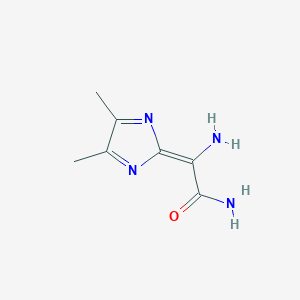|
Name: 4F-MDMB-BINACA (4F-MDMB-BUTINACA or methyl 2-(1-(4-fluorobutyl)-1H-indazole-3-carboxamido)-3,3dimethylbutanoate)
Type:
AKA: N/A

|
|
II. Natural Derivative
Synthetic substance, no natural derivative
 |
|
III. Chemical Profile (IUPAC name)

|
|
IV. History
4F-MDMB-BINACA, a synthetic cannabinoid, emerged in the early 2010s. Known for its psychoactive effects, it is part of a larger family of synthetic cannabinoids. Its history includes health risks and regulatory challenges due to its potency and effects.

|
|
V. Legal Information
4F-MDMB-BINACA is a synthetic cannabinoid with similar regulatory challenges to other cannabinoids. In the U.S., it falls under the Federal Analog Act, making its use and distribution illegal if it mimics controlled substances. Many countries have implemented strict controls to prevent abuse, reflecting trends in increasing regulation of synthetic cannabinoids. [Source: UNODC].
US Federal Schedule - I
Schedule I drugs, substances, or chemicals are defined as drugs with no currently accepted medical use and a high potential for abuse. Some examples of Schedule I drugs are: heroin, lysergic acid diethylamide (LSD), marijuana (cannabis), 3,4-methylenedioxymethamphetamine (ecstasy), methaqualone, and peyote.
Key US Federal Policies:
Controlled Substances Act. Public Law: Public Law 91-513 (text can be found on GovInfo) (https://www.dea.gov/drug-information/csa). Date enacted: October 27, 1970.
|
|
VI. Physical Effects
4F-MDMB-BINACA is a synthetic cannabinoid with psychoactive effects. It acts as an upper, producing euphoria and altered perception. Short-term use can lead to intense effects, while long-term impacts are not well-documented. Overdose risks include severe psychological effects and potential toxicity. Safe use is uncertain due to limited research. Recent studies focus on its psychoactive properties and health risks.  |
|
VII. Psychological Effects
This synthetic cannabinoid causes euphoria and altered perception. Long-term use may lead to severe psychological effects such as paranoia and cognitive impairments. Research emphasizes its impact on cannabinoid receptors and associated mental health risks.
 |
|
VIII. Culture
4F-MDMB-BINACA is a synthetic cannabinoid, part of a class of substances known for their powerful and often unpredictable effects. Emerging in the early 21st century, synthetic cannabinoids like 4F-MDMB-BINACA have been associated with significant public health concerns due to their potency and risk of adverse effects. Media coverage often focuses on their role in the rise of synthetic drug use and associated health crises. The substance is used recreationally rather than medicinally, contributing to societal debates about drug regulation and harm reduction. Proponents might argue for personal autonomy, while opponents emphasize the need for stricter controls and awareness about the risks involved.
 |
